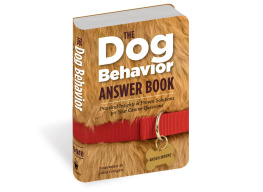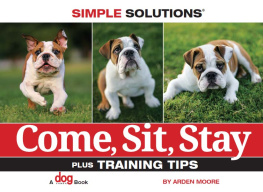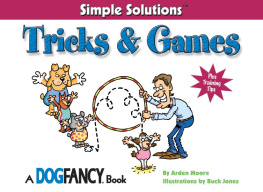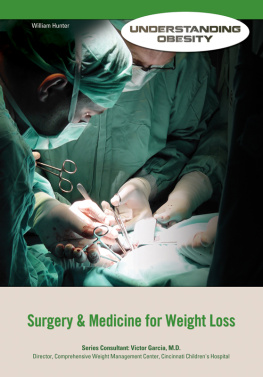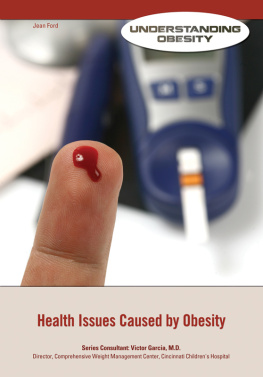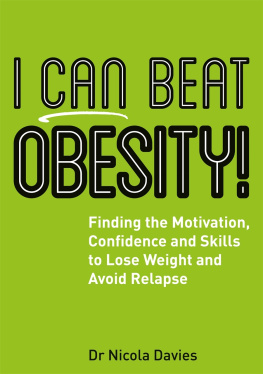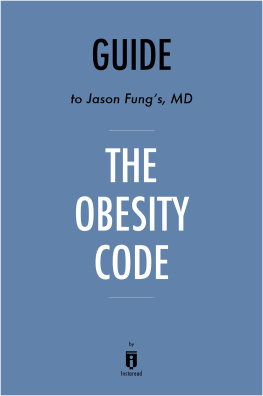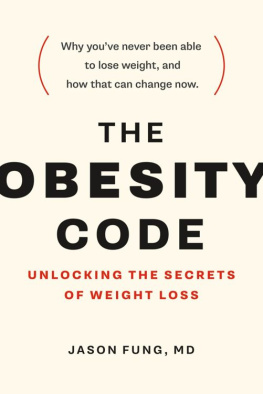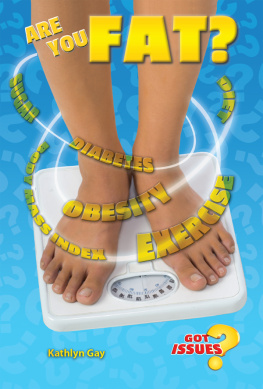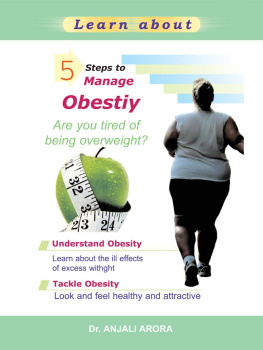Karla Austin, Business Operations Manager
Nick Clemente, Special Consultant
Jarelle S. Stein, Editor
Kendra Strey, Assistant Editor
Jill Dupont, Production
Michael Vincent Capozzi, Design
Copyright 2005 by I-5 Press
Illustrations copyright 2005 by Buck Jones
The dogs in this book are referred to as he and she in alternating chapters.
All rights reserved. No part of this book may be reproduced, stored in a retrieval system, or transmitted in any form by any means, electronic, mechanical, photocopying, recording, or otherwise, without the prior written permission of I-5 Press, except for the inclusion of brief quotations in an acknowledged review.
Library of Congress-in-Publication Data
Moore, Arden.
Obesity / by Arden Moore ; illustrations by Buck Jones.
p. cm. (Simple solutions)
ISBN 1-931993-62-9
eISBN: 9781620080740
1. DogFood. 2. DogsDiseasesNutritional aspects. 3. Obesity in animals. I. Title. II. Series: Simple solutions (Irvine, Calif.)
SF427.4.M658 2005
636.7'0896398dc22
2005004089
I-5 Press
A Division of I-5 Publishing, LLC
3 Burroughs
Irvine, California 92618
Printed and bound in Singapore
10 9 8 7 6 5 4 3 2 1
Contents
Introduction
T-r-e-a-t-s. For some dogs, saying this word or spelling it out can cause drool and delight. Face it, most dogs love food. They love food in their bowls and on the kitchen floor, and, if they get a chance, theyll steal the steak off your dinner plate. In the right amounts and with the right ingredients, food fuels our canine chums and keeps them healthy, fit, and strong. However, when we succumb to their begging eyes or go overboard in doling out fatty treats, we create chubby chowhoundsa serious issue that must not be ignored.

In fact, one in three dogs in the United States is deemed over-weight or downright obese. Whats wrong with a fat dog? Plenty. A combination of too much food and too little exercise creates a recipe for disaster. Plump pups are at risk for a host of chronic conditions and diseases including diabetes, heart problems, arthritis, and muscular injuries. Their expanding girths zap their puppylike enthusiasm. Their once-energetic strides turn into slow-moving waddles. They begin to prefer napping to ball fetching. They become couch pet-tatoes, getting up only when they smell a beef roast in the oven or hear the crackling sound of a new bag of treats being opened.

Think about ityour dog isnt opening up the refrigerator on her own and helping herself to midnight snacks. She isnt stealing your car keys and making a mad dash to a fast-food restaurants drive-through window and ordering a burger and friessuper size, please. The blame for the bulge is at the other end of the leash: well-meaning owners.
OK, we can admit our mistakes. After all, were only human. We can take this opportunity to establish good eating habits for our dogs. This book offers easy and effective ways to keep our beloved dogs happy, healthy, and fit. Lets get started!
Facing the Fat Facts
Many dog owners have a hard time recognizing how easily their pets become obese because the weight gain is gradual. Some find it cute that a tubby cocker spaniel resembles a hairy, waddling ottoman; however, they overlook the seriousness of the pups weight gain. Excess weight can reduce the length of a dogs life by as much as 20 percent. In humans, this is the equivalent of nearly fifteen years. An estimated fifteen million dogsroughly the combined populations of the states of Pennsylvania and Kansasare overweight.
Love your burgers? So does your dog. But fast food puts pounds on your poochfast. Caloriewise, one burger with all the trimmings fed to a 40-pound dog is the equivalent of a 150-pound person eating six burgers. So, if you cant resist the drive-through menu when your pet is along for the ride, stash a low-calorie dog treat in your glove box and serve this healthier option to your burger-begging pup.
The impact of a few extra pounds can weigh mightily on your dog. An extra 5 pounds may not sound like much, but to a 40-pound dog, its the equivalent to a 150-pound person gaining more than 20 pounds. Now that youve digested these facts, youre ready to unleash a weight loss plan. Not sure where your dog weighs in? Fit or fat? The following chapters help you earn a PhD without heading back to collegea PhD that stands for Pretty Healthy Dog.


Is My Dog Fit or Fat?
Any dog can become a chowhound, but some breeds are more prone to beefing up. Pay special attention to what you dole out if your dog is one of these food-loving breeds: basset hounds, beagles, cairn terriers, cocker spaniels, collies, dachshunds, Doberman pinschers, Labrador retrievers, Scottish terriers, shelties, and West Highland white terriers. If your breed isnt listed, youre not off the hookany dog can gain weight quickly with too much food and too little exercise.
There are different levels of severity for overweight dogs. The worst is obese, which describes a dog who weighs 30 percent or more than the ideal weight for her age, gender, and particular breed. She is overweight if she weighs between 20 and 25 percent more than her ideal weight.
Below are average weights for some of the more popular breeds. Please keep in mind that your dog may weigh slightly more or less, depending on her age, activity level, and state of health.
Lets start with some examples of healthy weights (in pounds) for dogs among the toy breeds: a Chihuahua, 4; a Pekingese, 9; a miniature schnauzer, 15; and a Boston terrier, 19. Among medium breeds: a beagle or Pembroke Welsh corgi, 30; a Brittany, 35; a Siberian husky or Airedale terrier, 50; and a standard poodle, 55.
Among large breeds: a golden retriever, 70; and an Old English sheepdog, 95.
Among giant breeds: a Great Pyrenees, 115; a Great Dane, 130; a Newfoundland, 140; and a Saint Bernard, 165.
The rib test offers an effective way to determine if your dog weighs in at her ideal poundage. To judge, you need to look at your dogs body condition instead of a scale. Here is a step-by-step guide to performing this test at home:
Stand in front of your dog. Examine her standing body profile. She should have a clearly defined abdomen, slightly tucked up behind her rib cage.
Stand over your dog. From this view, most dogs have an hourglass shape and a visible waistline.
Gently run your fingers over your dogs backbone and spread your hands across her rib cage. You should be able to feel each rib.
You can easily feel a fit dogs ribs because there is not a lot of surrounding fat. Looking from the side, you should see that her abdomen is tucked up; looking from above, you will see the hourglass shape.
An overweight dogs waist is barely defined, and you may see fat deposits over the lumbar area and base of the tail. You will be able to feel the ribs, but just barely.
Youll find that an obese dog has fat deposits readily visible on the neck, limbs, spine, and base of tail. You will notice an absence of the tucked-in waist or abdomen. (Please note that a senior dog may have a slightly sagging abdomen, which could be attributed to her age rather than to her weight.)
Next page

